
A Sticky at the End
The oldest recorded golf club in the world
Most people would be delighted to be playing at Muirfield. I was far above delighted, I was ecstatic. Playing golf at the home course of The Honourable Company of Edinburgh Golfers is a rare privilege indeed; and many a grown man has been known to grovel to get onto this course. Founded in 1744, it is the oldest recorded golf club in the world, and right now sits firmly on its perch at #12 on the GOLF Magazine Top 100 list. Most probably it has been in the Top 15 ever since the list was drawn up.
Like many courses in the early years, it started with far fewer than eighteen holes. This didn’t become the norm until ten years after The Society of St Andrews Golfers was formed in 1754. In fact, the Leith Golfers, who later became The Honourable Company of Edinburgh Golfers (HCEG), played their golf over just five holes in Leith. The Club moved to Musselburgh in 1836, where they played within the racecourse, which has continued to serve as a horse racing venue until this day. Some thirty years later, when the Musselburgh course was shared by four clubs, overcrowding led to the Club moving again.
In 1891, the course at Muirfield that opened for play was designed by Old Tom Morris as sixteen holes. Two more holes were added a few months later. In 1928, Harry Colt and Tom Simpson made alterations to the layout. It was the first to be designed with two concentric rings of nine. The outward nine run clockwise and the inward nine run counterclockwise. Muirfield has been host to 15 Opens, starting in 1892; and the Open Championship is returning in 2013. Not that the pedigree needs any enhancing, Muirfield has also staged many other premier amateur championships, along with the Ryder Cup, Walker and Curtis Cups.
The memorable Greywalls and its exquisite gardens
 Our sure-to-be memorable day began with meeting Kevin’s good friend and fellow Dubliner, Peter Webster, at Greywalls, a very posh hotel situated next to Muirfield, overlooking the greens of the 9th and 18th holes.
Our sure-to-be memorable day began with meeting Kevin’s good friend and fellow Dubliner, Peter Webster, at Greywalls, a very posh hotel situated next to Muirfield, overlooking the greens of the 9th and 18th holes.
We found Peter reading the paper and enjoying a cup of tea in the elegant library. He was impeccably dressed in the required jacket and tie. While we waited for tea ourselves, I browsed through a book about the celebrated Edwardian architect, Sir Edwin Lutyens (1869-1944), who designed the Country House in 1901 for the Hon. Alfred Lyttelton. Alfred was a keen golfer who wanted to be “within a mashie niblick of the eighteenth green of Muirfield.” (Today that would be the equivalent of an 8- or 9-iron.)
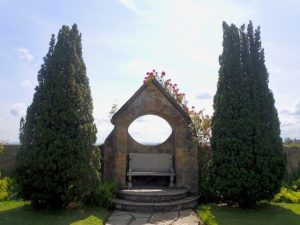 Peter was aware of a special architectural feature in the garden. He insisted, “You must not miss the clair-voyee,” and I was out of my winged-back chair faster than you could say White Rabbit!
Peter was aware of a special architectural feature in the garden. He insisted, “You must not miss the clair-voyee,” and I was out of my winged-back chair faster than you could say White Rabbit!
Like Alice in Wonderland, I found myself in the most magical place teeming with all manner of cool and fiery colored flowers and secret shady places full of gorgeous ornamental gates and elaborate stone statues. Although I did not come across a Cheshire Cat or make it as far as the croquet lawn (surely it was inhabited by flamingos?), I did discover the clair-voyee.
What a clever device. The oval-shaped opening in the garden wall was like a portal to another world. A little research revealed that the clair-voyee was common in French gardens of the seventeenth century and was usually placed at the end of a walk to extend the view outward and “call in” the countryside.
The garden embodied endless charm. No wonder. It was designed by Gertrude Jekyll (1843-1932), who collaborated with Lutyens on scores of gardens, and as England’s most venerated designer, she was revered as a national heroine. And, it was this prolific designer who introduced Lutyens to most of his early clients. Considered bilingual, speaking both art and horticulture, her philosophy was distilled from the Arts and Crafts Movement, which expounded on the importance of creating with heart, hand and eye.
Influenced by her studies in London, travels abroad, and her association with William Morris, Jekyll’s own personal unity of the aesthetic arts led her to practice many other crafts such as embroidery, metalwork, woodwork, painting and later photography, before taking up garden design. Without knowing at the time who created this multi-layered living tapestry, I felt a deep connection to this pleasing place and found it hard to tear myself away. What a superb appetizer to our main course!
The gate that stops you – to marvel at it!
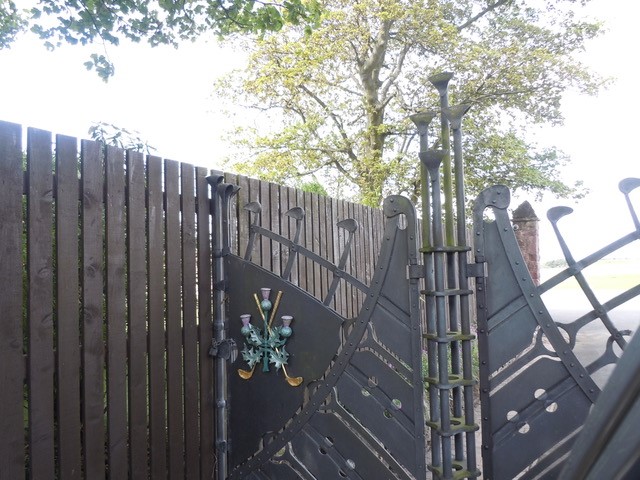 Our appointed time arrived to meet the Master of our Muirfield experience, David Sanderson. A recipe for a better host you could not conjure up. He was generous portions of gracious, bright, charming and funny, topped off with a huge dollop of excellent golfer.
Our appointed time arrived to meet the Master of our Muirfield experience, David Sanderson. A recipe for a better host you could not conjure up. He was generous portions of gracious, bright, charming and funny, topped off with a huge dollop of excellent golfer.
Starting when you arrive at the massive iron gate, cleverly designed with golf club and ball elements, plus elegant raised lettering, you know you are someplace special. In fact, I was so blown away by this monumental work of art that I later wrote to the owner of the company. This detail is all part of his reply:
“The gates were commissioned in 1999 by the then-Captain of Muirfield, Mr. J. B. Neil, and the design was developed by Phil Johnson & Jois Hunter.
The whole main gate is part of a giant golf ball with 18 holes scattered
about the lower section.Inside the trophy cabinet of the Clubhouse there are a number of silver golf clubs displayed, each with a silver ball attached (one for every club captain). These silver balls are represented by negative/positive discs holding the lower solid panels in place. There is more…can you find any Birdies, or Eagles, or Albatrosses?
The thistle and clubs are the Coat of Arms of The Company. As you say, the components were forged separately and then assembled onto the back plate, as was the lettering on the pedestrian gate.
The gates and panels and posts were riveted together after all the components were forged and shaped. The assemblies were first galvanised, then painted and finally the coat of arms was overpainted in the appropriate colours and the lettering gold leafed.
The main gates, which are automated, were installed in July 2000.
There is just over a ton and a half of steel in the whole work. They took us seven hundred and twenty eight and a half hours to make.”
Now you know why I was blown away.
The protocols of Muirfield
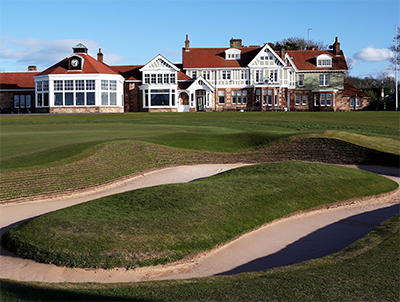 Once inside the gates, it was just a short walk to the clubhouse entrance, where the men continued on to their locker room and I was escorted back outside to a little walkway leading to the ladies locker room.
Once inside the gates, it was just a short walk to the clubhouse entrance, where the men continued on to their locker room and I was escorted back outside to a little walkway leading to the ladies locker room.
Modest and tidy, with a single cushioned bench running down the length of it, the locker room did actually have small lockers under the bench, where I stowed a few things. My escort then brought me back to the main clubhouse so I could join the men for a drink before lunch.
One understands why all the protocols of Muirfield are what they are when you know the essential ingredients of how the club was formed. I read about it in previous research, but here it is, extracted from the official Muirfield And The Honourable Company by George Pottinger, a copy of which my genial host bestowed on me as a gift:
“Golf at Leith Links—and at St Andrews and Perth—was becoming more popular every year, but there was as yet no sign of any corporate body or collection of individuals forming a club or society to promote their common interest in the game. The establishment of the Company of Gentlemen Golfers in the 1740s seems to have come from the golfers’ habit of taking refreshment at a particular tavern after their exercise.
The Gentlemen Golfers were accustomed to meet for this laudable purpose at Luckie Clephan’s tavern at Leith. Clephan was an innkeeper and clubmaker who died in 1742 and it was the house of his widow that became the Company’s first headquarters.”
So there you are. Now bring on that drink while I sit back and absorb the atmosphere of the Smoking Room wherein many of the crown jewels hang on the walls.
A magnificent portrait of William St. Clair of Roslin (1700-1778) commanded my attention as he towered over me in his red coat, holding a long wooden club, probably addressing a feathery golf ball. The small attached plaque explained that St. Clair was “the last of a line said to have come to Britain with William the Conqueror.” He was the Club Captain 1761, 1766, 1770 and 1771. I was informed by my escort that the original is actually in a vault and this one is a reproduction. It is technically “after the portrait by Sir George Chalmers”.
The other painting that engaged my attention was called “A Club Dinner” by Angus Hampet. It was commissioned by a member, G.A. McElveen III, and presented to the Club in 2008. Sadly he did not live to see its completion. It was a festive scene of dozens of members, seated for dinner in their red jackets—quite atmospheric and almost Degas-esque.
We were soon called to lunch. It was quite a lavish affair. We sat in a large airy room with a view of the course. It was a lively ambience with all the gentlemen in coat and tie. I noticed a few people had plates full of cold salad foods, and realized I was supposed to serve myself, and so I did, thinking that was the lunch.
Not the case at all! There was an entire hot meal being served at the other end of the elegant dining hall, with several carved meats and miles of vegetables. Oh. Now I am sorry I had an extra bite or two of beets. While we were consuming lavish amounts of delicious food, the entire salad table was replaced with desserts. How would one attempt to resist?
The ‘Scotch’ Foursome
After lunch, I changed into my golf shoes in the ladies’ locker room and met the lads on the first
tee, where Peter announced, “You and Stallion are a team.”
Now for the other key component of the Muirfield Recipe, also extracted from the Muirfield history book:
“The Honourable Company is the home of the Foursome—sometimes called the ‘Scotch’ Foursome—and regards it as the true game, the epitome of all that is best in golf.
A prominent Notice hangs beside the entrance to the clubhouse at Muirfield, saying: ‘Fourball games are forbidden at weekends and on public holidays.’ Any member (or visitor) who attempted to break this rule would get short shrift. And, if it be reported that a player plays twice as many shots in a fourball game as in a Foursome, the Muirfield man would reply, ‘Play 36 holes in 4 1/2 hours (as we do) and you will get the same number of shots, twice the exercise, far more fun, and you won’t have to wait between shots. Furthermore you will learn to play golf better.’”
I was intoxicated by all I was experiencing and didn’t play my best golf or anything close to it. I did, however, have the most fun and never waited between shots—that is, until we got to the fourteenth hole. This long par-4 (par-5 for ladies) follows a par-3 with an elevated green. The members’ tees were around the dune and my forward tee was below, so I didn’t follow Peter up to his tee box, nor could I follow where he hit his drive. Kevin and David were already walking through the rough; David along the left and Kevin along the right side of the fairway.
After I heard Peter’s strike and saw that he was on his way down from the tee box, I got set to hit my drive. It landed in the light rough on the right side of the fairway. Peter evidently was in deeper rough on the left. David went over to help him search for his ball.
We saw that the group behind us had already reached the fourteenth tee. We waved them through, staying clear of the fairway. Mindful that we didn’t want to hold them up, but over 200 yards away and not in earshot, Kevin and I had a little chat.
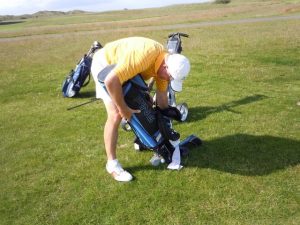 And then zzzzuuummmmp! Into my golf bag went a ball. As soon as Kevin realized what had happened, he keeled over in laughter. Peter and David were now calling out and waving vigorously, thinking Kevin had been hit by a golf ball.
And then zzzzuuummmmp! Into my golf bag went a ball. As soon as Kevin realized what had happened, he keeled over in laughter. Peter and David were now calling out and waving vigorously, thinking Kevin had been hit by a golf ball.
Kevin and I were laughing ourselves silly. He picked up my bag, turned it upside down, and shook it to coerce the ball to come out. About this time, the hapless golfer, clad in a Pebble Beach shirt and wearing an angry frown, arrived at this comical scene. Only he didn’t find it funny in the least. But why not? He just had a hole-in-one!
We backed away from where his ball lay, and kept quiet as he took an angry swipe at it, shooting us dirty looks and muttering to his caddie. One hates to be the reason for another’s card-wrecking hole. Since we now had to continue waiting—Kevin would be playing the next shot with his fairway driver—in between the giggles, we pitied this joyless fellow who could not embrace the hilarity of the mishap, as he was so driven by his score.
Out of rhythm now with our own game, and not wanting to crowd this sorrowful soul, we walked a half step slower to keep out of the slipstream of the sourpuss.
The Original 13 Rules of Golf
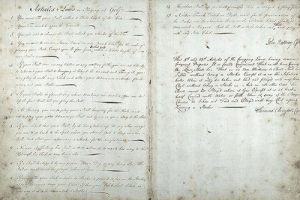 But we regained our collective good spirit and carried on to the eighteenth hole, allowing our bonhomie to carry us back in to the clubhouse. David then offered us a tour upstairs so we could see the Original 13 Rules of Golf.
But we regained our collective good spirit and carried on to the eighteenth hole, allowing our bonhomie to carry us back in to the clubhouse. David then offered us a tour upstairs so we could see the Original 13 Rules of Golf.
Like the Roslin painting, it was a facsimile, but nonetheless, it was a thrill to see the Rules written in the hand of John Rattray, first Captain of the Club. It was impossible to take it all in, but one other tasty morsel of memorabilia stuck in my mind: the scorecard of Mr. B.A.D.T.M. Shade, otherwise known as Mr. Bloody Always Down The Middle Shade, who shot a 70 on this par 71 course.
Although we didn’t follow the complete protocol for the Muirfield members—especially in the early days when they met at the tavern (these were “no half-pint men”, mind you), perhaps aptly described by Tobias Smollet in his 1771 epistolary novel The Expeditions of Humphry Clinker. He recalled the golfers he saw on the Leith Links: “They never went to bed without the best part of a gallon of claret in his belly.”
However we were informed of the members’ ritual of the day’s golf-lunch-golf round involving a Sticky, which consisted of a liqueur—a particular favorite at Muirfield being Kummel.
Our convivial host described this most agreeable liquid course this way:
“There is a tradition of self-pouring stickys at our club to create a meniscus at the top of the glass. Often as not, this is broken during the journey to one’s seat with unsteady hands resulting in sticky hands. They are had with coffee in the smoke room at the end of lunch before we go out for our afternoon round. Sticky hands can be helpful for holding on to golf clubs after lunch…”
And certainly the Sticky at the end was especially helpful for holding on to the great camaraderie of the round itself!
A Sticky at the End is the third story in Taba’s newly published Golfers, Scotland Is Calling



 When Young Tom won the belt three times in a row (1868, 1869 and 1870) it was his to keep forever as stipulated in the conditions of the competition. He actually won The Open four consecutive times, but since he already owned the magnificent Challenge Belt and a new trophy was not organized in time, the competition was cancelled in 1871. Imagine…cancelled. Wouldn’t happen today of course over lack of a trophy. A world war, yes, but a trophy, I don’t think so.
When Young Tom won the belt three times in a row (1868, 1869 and 1870) it was his to keep forever as stipulated in the conditions of the competition. He actually won The Open four consecutive times, but since he already owned the magnificent Challenge Belt and a new trophy was not organized in time, the competition was cancelled in 1871. Imagine…cancelled. Wouldn’t happen today of course over lack of a trophy. A world war, yes, but a trophy, I don’t think so. The winner of the 1873 Open Championship, Tom Kidd, was the first to receive the new trophy, but there must have been some consolation for Young Tom, because his name was the first to be engraved on it.
The winner of the 1873 Open Championship, Tom Kidd, was the first to receive the new trophy, but there must have been some consolation for Young Tom, because his name was the first to be engraved on it. The Ailsa Craig climbs out of the Firth of Clyde, and is a volcanic island that is presently uninhabited except for large colonies of gannets and puffins. Even using the power of the zoom on my Nikon camera, I could barely make out the lighthouse and the ruins of the 16th century castle.
The Ailsa Craig climbs out of the Firth of Clyde, and is a volcanic island that is presently uninhabited except for large colonies of gannets and puffins. Even using the power of the zoom on my Nikon camera, I could barely make out the lighthouse and the ruins of the 16th century castle. In the middle of our ebullient mood, though, there was one sad moment. Ken took us into the Members Card Room. He pointed out a photo of Lady Diana, Princess of Wales, hanging on the wall by a round table and four chairs. I was already choked up when I said to Ken, “It is such a surprise to see a photograph of Lady Di here.”
In the middle of our ebullient mood, though, there was one sad moment. Ken took us into the Members Card Room. He pointed out a photo of Lady Diana, Princess of Wales, hanging on the wall by a round table and four chairs. I was already choked up when I said to Ken, “It is such a surprise to see a photograph of Lady Di here.”


 Kevin reveled in the sweet memory. “Twelve pars and five birdies for those seventeen holes was as good a game of golf I had ever played in my whole life.”
Kevin reveled in the sweet memory. “Twelve pars and five birdies for those seventeen holes was as good a game of golf I had ever played in my whole life.”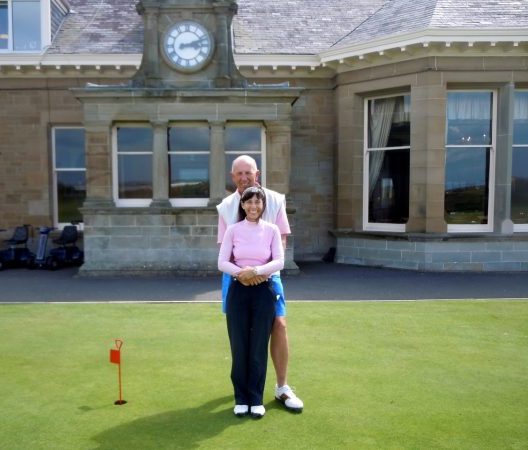 But then Kevin perked up and said, “I’m happy to say that several years later, when all of the aging regular rascals who participated in this event, decided the tournament should just be one round, I shot a 1 under par gross 70, this time off a 5-handicap.”
But then Kevin perked up and said, “I’m happy to say that several years later, when all of the aging regular rascals who participated in this event, decided the tournament should just be one round, I shot a 1 under par gross 70, this time off a 5-handicap.”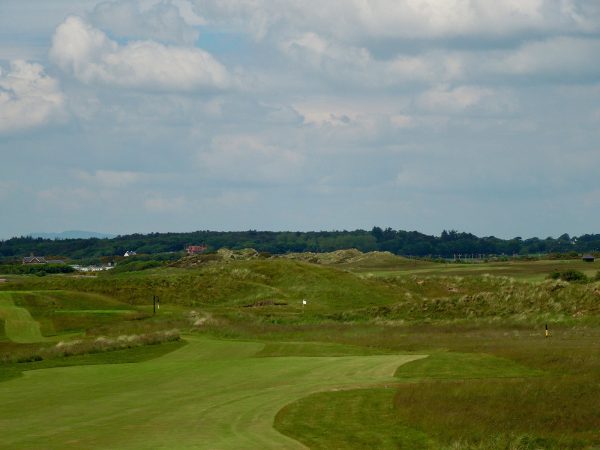 Just about every other hole Kevin said, “The greens seem much larger,” or “This hole is much longer than I remember it.” Like in the story Kevin told me earlier, he is clearly one of those guys whose brain is wired to remember every shot he ever hit on every course he’s ever played; and he’s probably right. Not that Kevin is playing the championship tees, but the course has been stretched to 6,908 yards.
Just about every other hole Kevin said, “The greens seem much larger,” or “This hole is much longer than I remember it.” Like in the story Kevin told me earlier, he is clearly one of those guys whose brain is wired to remember every shot he ever hit on every course he’s ever played; and he’s probably right. Not that Kevin is playing the championship tees, but the course has been stretched to 6,908 yards.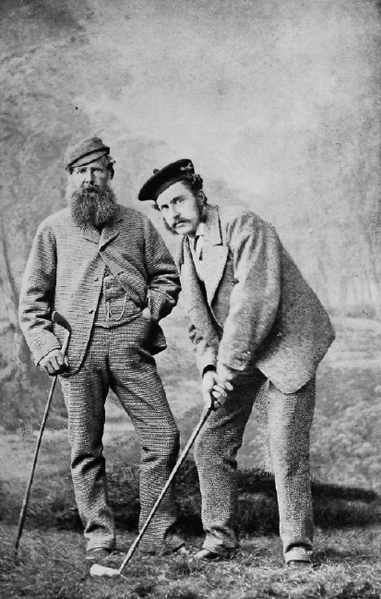 And may I further point out that Young Tom played in his first Open at age 14. Young Tom’s first Open Championship win, in 1868 at age 17, made him the youngest major champion in golf history, a record which still stands.
And may I further point out that Young Tom played in his first Open at age 14. Young Tom’s first Open Championship win, in 1868 at age 17, made him the youngest major champion in golf history, a record which still stands.
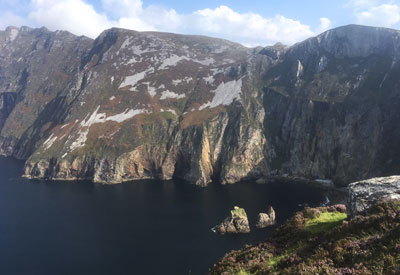 These are the highest cliffs in all of Ireland. Although one of Ireland’s best kept secrets, they rise almost three times higher than the Cliffs of Moher — nearly 2000 feet. I had never heard of them. Astonishing.
These are the highest cliffs in all of Ireland. Although one of Ireland’s best kept secrets, they rise almost three times higher than the Cliffs of Moher — nearly 2000 feet. I had never heard of them. Astonishing.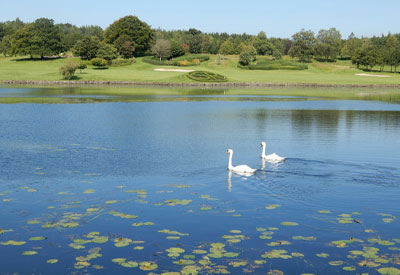 Our first destination was County Cavan so that Kevin could play in the Ulster Seniors Golf Championship. The 2020 venue was Slieve Russell Hotel Golf & Country Club on their fine parkland course. We had a sumptuous room with a view of the rose garden and 18th green. To make everything more delightful, we had warm sunshine. Perfect weather and great camaraderie, unfortunately did not add up to a winning score for Kevin. In spite of those 3-putts on the tricky greens, we both thoroughly enjoyed the luxurious experience.
Our first destination was County Cavan so that Kevin could play in the Ulster Seniors Golf Championship. The 2020 venue was Slieve Russell Hotel Golf & Country Club on their fine parkland course. We had a sumptuous room with a view of the rose garden and 18th green. To make everything more delightful, we had warm sunshine. Perfect weather and great camaraderie, unfortunately did not add up to a winning score for Kevin. In spite of those 3-putts on the tricky greens, we both thoroughly enjoyed the luxurious experience.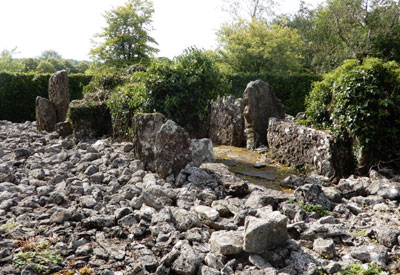 But it was the amazing prehistoric monument hiding in the Secret Garden that absolutely blew me away. It is called the Aughrim Wedge Tomb. It was originally located on the slopes of the Slieve Rushen mountain. The Quinn Group, who built the hotel, were quarrying there when it was unearthed. They engaged Mr. John Channing, Archeologist, to oversee the excavation in 1992. It was then carefully reconstructed on the grounds of the hotel rather than have it disappear forever. To some, it may be sacrilegious to move what the local folklore call “The Giant’s Grave”, but the trade off is, many more people will see it and have a peek at the ancient past of this part of Ireland.
But it was the amazing prehistoric monument hiding in the Secret Garden that absolutely blew me away. It is called the Aughrim Wedge Tomb. It was originally located on the slopes of the Slieve Rushen mountain. The Quinn Group, who built the hotel, were quarrying there when it was unearthed. They engaged Mr. John Channing, Archeologist, to oversee the excavation in 1992. It was then carefully reconstructed on the grounds of the hotel rather than have it disappear forever. To some, it may be sacrilegious to move what the local folklore call “The Giant’s Grave”, but the trade off is, many more people will see it and have a peek at the ancient past of this part of Ireland.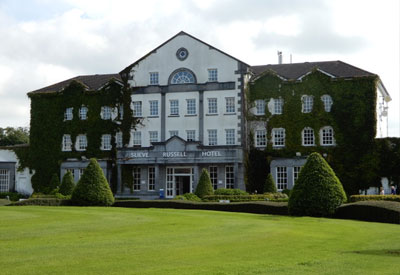 The entire hotel property is situated about 85 miles northwest of Dublin. Many would regard it as the middle of nowhere. Our antiquated GPS took us on a network of single track roads. The grass growing down the middle, shall we say, tickled the bottom of our low-slung BMW sedan. By the time we reached the Slieve Russell Hotel, for us, it did feel like it was light years away from anything resembling a city. In other words, purely idyllic.
The entire hotel property is situated about 85 miles northwest of Dublin. Many would regard it as the middle of nowhere. Our antiquated GPS took us on a network of single track roads. The grass growing down the middle, shall we say, tickled the bottom of our low-slung BMW sedan. By the time we reached the Slieve Russell Hotel, for us, it did feel like it was light years away from anything resembling a city. In other words, purely idyllic.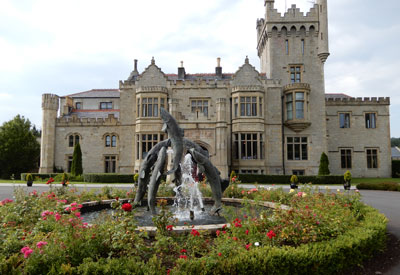 Knowing that Kevin and I are the leaders of this group, the hotel management put us in a magnificent suite. We were barely in the door of our luxurious light-filled cocoon, when we spotted the chocolate covered strawberries. After quickly stashing our suitcases, we smuggled the strawberries over to The Gallery Bar, where we sat outside in the glorious sunshine and enjoyed them with a lovely glass of perfectly chilled Prosecco. Well, I did. I think Kevin had a shandy.
Knowing that Kevin and I are the leaders of this group, the hotel management put us in a magnificent suite. We were barely in the door of our luxurious light-filled cocoon, when we spotted the chocolate covered strawberries. After quickly stashing our suitcases, we smuggled the strawberries over to The Gallery Bar, where we sat outside in the glorious sunshine and enjoyed them with a lovely glass of perfectly chilled Prosecco. Well, I did. I think Kevin had a shandy.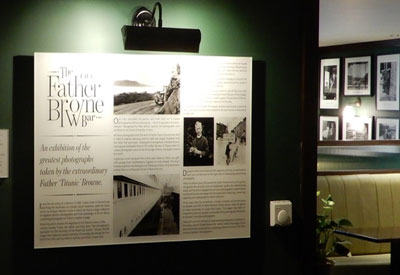 I may know fine art, fine framing and expert placement of a large photographic collection, but I was completely humbled by not having a clue to who is this artist. Although Father Francis Browne, a Jesuit priest, had died in relative obscurity in 1960, when his work was discovered, one critic compared him to the famous French photographer, Henri Cartier-Bresson.
I may know fine art, fine framing and expert placement of a large photographic collection, but I was completely humbled by not having a clue to who is this artist. Although Father Francis Browne, a Jesuit priest, had died in relative obscurity in 1960, when his work was discovered, one critic compared him to the famous French photographer, Henri Cartier-Bresson.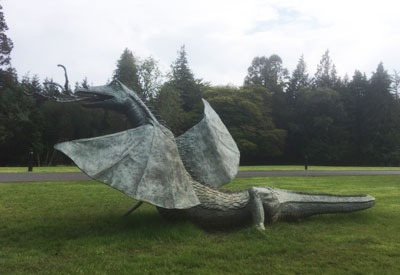 I was thrilled to be able to show Father Browne’s Bar to Kevin before our dinner. While doing our site visit the next morning with Stephen Bell, the Sales Manager of the hotel, he also showed us an elegant room tucked away off the main part of the bar where we can have a private Welcome Dinner for our guests in July 2021. Then we also have the perfect venue for our musicians to entertain everybody back out in the bar area, while the pints are flowing.
I was thrilled to be able to show Father Browne’s Bar to Kevin before our dinner. While doing our site visit the next morning with Stephen Bell, the Sales Manager of the hotel, he also showed us an elegant room tucked away off the main part of the bar where we can have a private Welcome Dinner for our guests in July 2021. Then we also have the perfect venue for our musicians to entertain everybody back out in the bar area, while the pints are flowing. We packed a lot into our five-day trip to Cavan and Donegal — two counties in Ulster. (Ulster is one of four provinces of Ireland. The remaining three are Leinster to the east, Munster to the south and Connacht to the west.) We live in Liscannor near Lahinch, in County Clare. This is Munster. So it was great to see another part of Ireland. It was almost like going to another country.
We packed a lot into our five-day trip to Cavan and Donegal — two counties in Ulster. (Ulster is one of four provinces of Ireland. The remaining three are Leinster to the east, Munster to the south and Connacht to the west.) We live in Liscannor near Lahinch, in County Clare. This is Munster. So it was great to see another part of Ireland. It was almost like going to another country.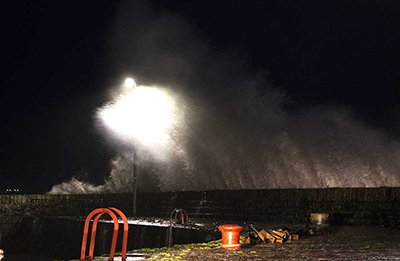 When she did arrive in the dark of the night she brought the entire percussion section of a hundred orchestras with her. Drums of heroic dimensions. Timpani yes, but modest bodhrán, no. Ellen seemed to be trying to find a way to the center of the Earth. She pummeled the whole house, as if we alone stood in her way to the deep underground cave she was seeking.
When she did arrive in the dark of the night she brought the entire percussion section of a hundred orchestras with her. Drums of heroic dimensions. Timpani yes, but modest bodhrán, no. Ellen seemed to be trying to find a way to the center of the Earth. She pummeled the whole house, as if we alone stood in her way to the deep underground cave she was seeking.
 The wind is ever-present when you are by the sea. It can be refreshing like it was today, especially while we’re keeping up a good pace going down a quaint, single-track road. It is one of the things I love about our rural part of County Clare, when you come across a road with grass growing down the middle and can feel miles away from anything resembling a city.
The wind is ever-present when you are by the sea. It can be refreshing like it was today, especially while we’re keeping up a good pace going down a quaint, single-track road. It is one of the things I love about our rural part of County Clare, when you come across a road with grass growing down the middle and can feel miles away from anything resembling a city.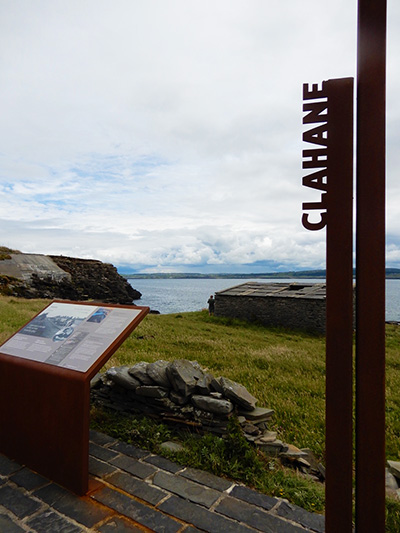 The road bends a bit as we start a slight incline. We are confronted by a stern sign, warning us of Extreme Danger, and suddenly the cliffs are in our view. Mind you, they are modest compared to the Cliffs of Moher, but I’m not going anywhere near the edge. Uh uh. I’m sticking to the wee road.
The road bends a bit as we start a slight incline. We are confronted by a stern sign, warning us of Extreme Danger, and suddenly the cliffs are in our view. Mind you, they are modest compared to the Cliffs of Moher, but I’m not going anywhere near the edge. Uh uh. I’m sticking to the wee road. Right, a couple of ingenious guys wheeled a truck close to the flaggy shore, and were pumping sea water into a bevy of large wooden barrels – appropriately spaced more than six feet apart – so people could immerse themselves in warm sea baths.
Right, a couple of ingenious guys wheeled a truck close to the flaggy shore, and were pumping sea water into a bevy of large wooden barrels – appropriately spaced more than six feet apart – so people could immerse themselves in warm sea baths.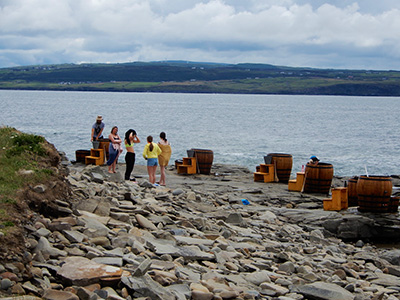 Scientific studies have confirmed that seaweed bathing helps lower body stress and relieve skin conditions (psoriasis, eczema, acne etc). It has also been shown to be beneficial in the treatment of muscle aches and joint stiffness (rheumatism and arthritis), and excellent for some circulatory problems.
Scientific studies have confirmed that seaweed bathing helps lower body stress and relieve skin conditions (psoriasis, eczema, acne etc). It has also been shown to be beneficial in the treatment of muscle aches and joint stiffness (rheumatism and arthritis), and excellent for some circulatory problems.
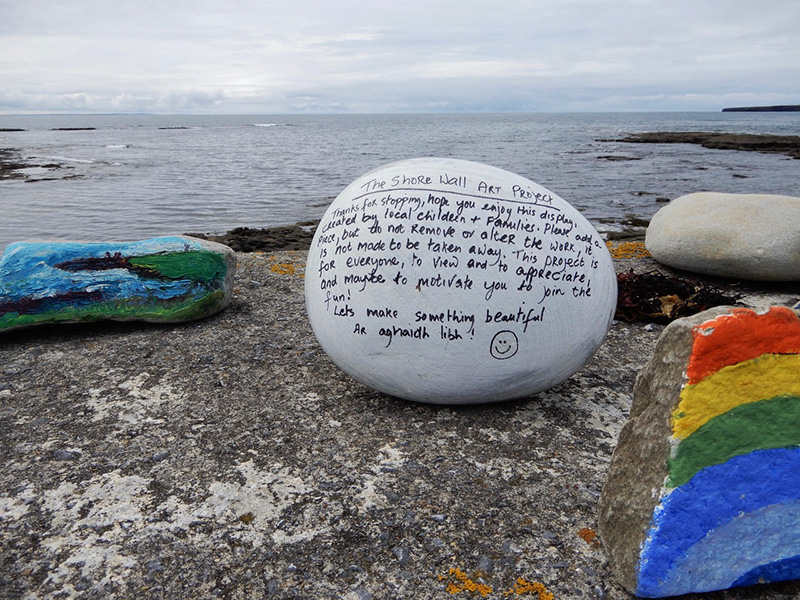
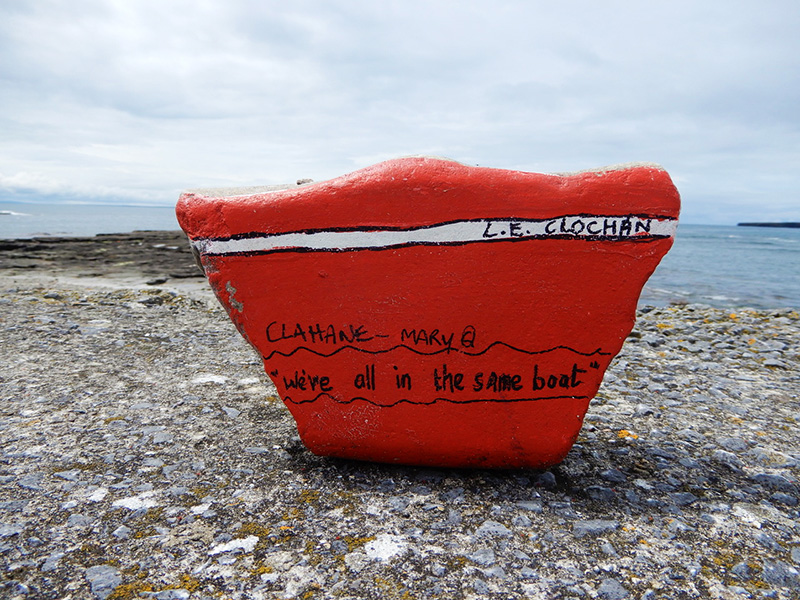
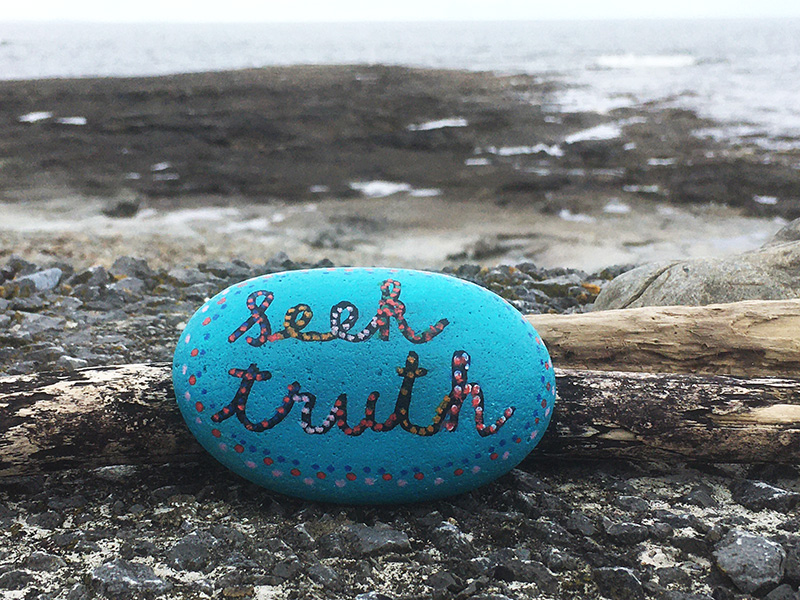
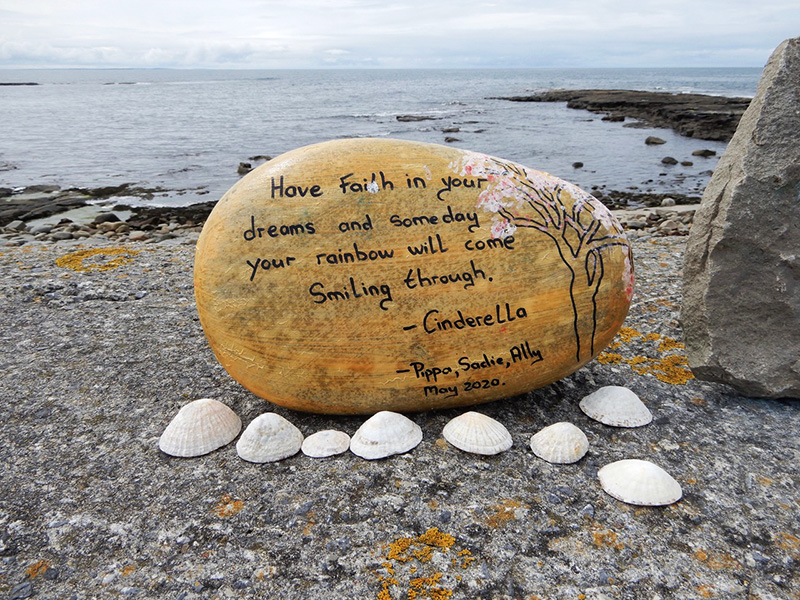
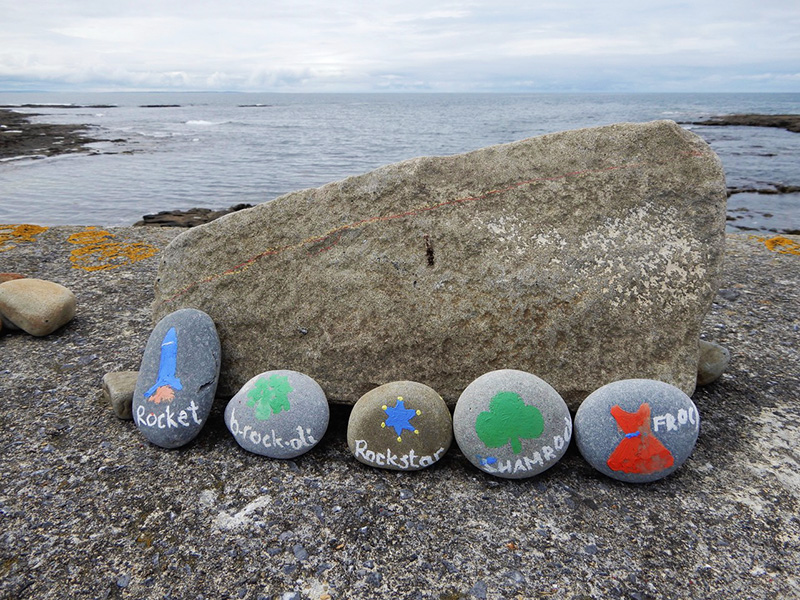
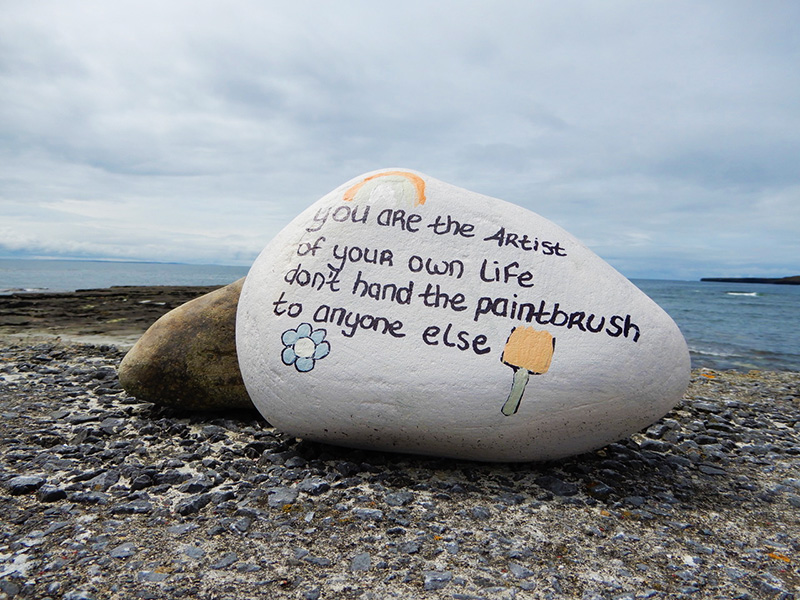


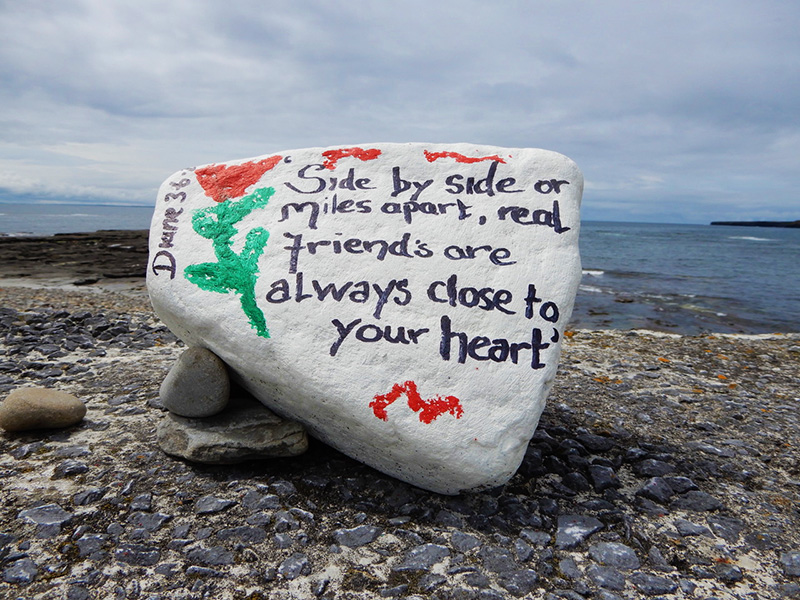
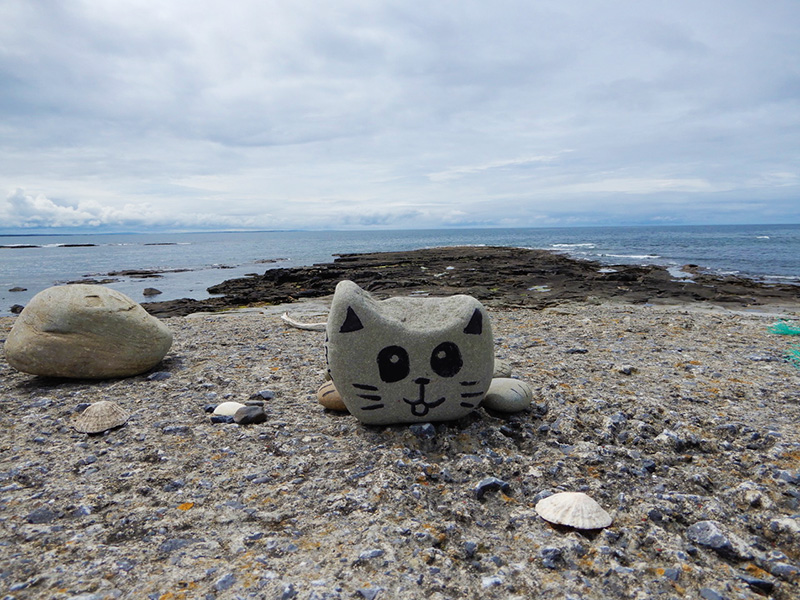
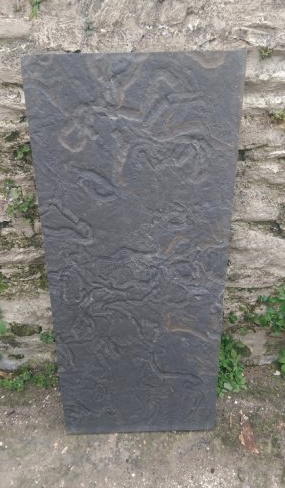 Clahane (An Clochán) is what the clever marketers call a “Discovery Point” along the Wild Atlantic Way, which stretches 2,500 miles along the coastline of Ireland. We are not far from Lahinch here. Further west, at Hag’s Head is the southern edge of the spectacular Cliffs of Moher, that rise 700 feet above the ocean.
Clahane (An Clochán) is what the clever marketers call a “Discovery Point” along the Wild Atlantic Way, which stretches 2,500 miles along the coastline of Ireland. We are not far from Lahinch here. Further west, at Hag’s Head is the southern edge of the spectacular Cliffs of Moher, that rise 700 feet above the ocean.



 Having learned some of the history of the bloody Battle of Culloden, which took place on April 16, 1746, I knew how the redcoats of Cumberland’s army bludgeoned the fierce but exhausted Clansmen on the Highland moor near Nairn. Charlie escaped and lived out the rest of his life in Rome, where he was born; but I do not know the details of where he went while on the run.
Having learned some of the history of the bloody Battle of Culloden, which took place on April 16, 1746, I knew how the redcoats of Cumberland’s army bludgeoned the fierce but exhausted Clansmen on the Highland moor near Nairn. Charlie escaped and lived out the rest of his life in Rome, where he was born; but I do not know the details of where he went while on the run. But both Kevin and I play white balls and we did not make the adjustment to adapt to the playing conditions of the course. We gave up after playing the first nine and could see from the course map that we could cut across to the 16th hole, then play the last two and find our way back to our car.
But both Kevin and I play white balls and we did not make the adjustment to adapt to the playing conditions of the course. We gave up after playing the first nine and could see from the course map that we could cut across to the 16th hole, then play the last two and find our way back to our car.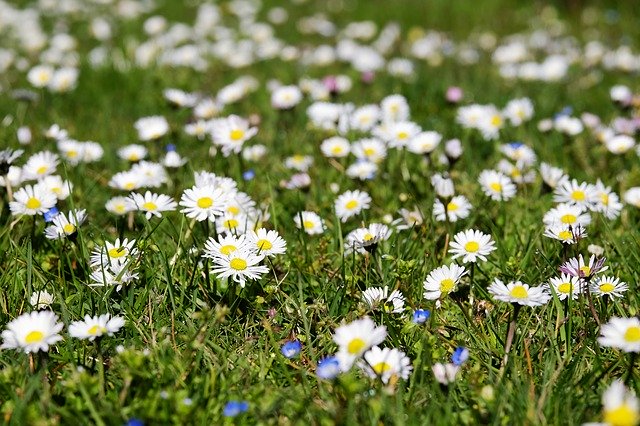 Golf in a place like Askernish is exhilarating and perhaps in equal measure, humbling. It felt like we were playing golf more like it would have been 400 years ago. It was primitive, even.
Golf in a place like Askernish is exhilarating and perhaps in equal measure, humbling. It felt like we were playing golf more like it would have been 400 years ago. It was primitive, even.
